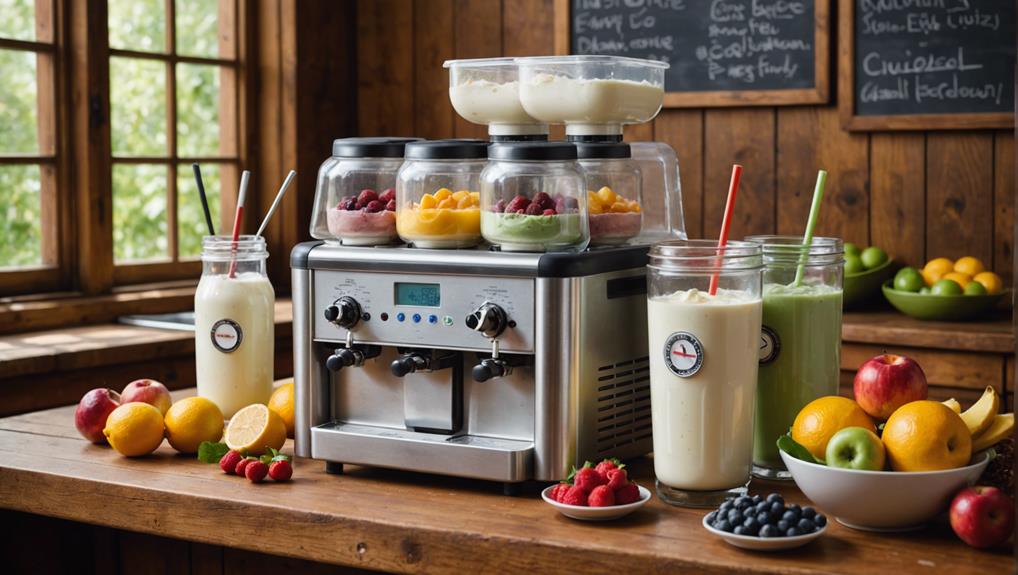Sensory evaluation of frozen yogurt systematically assesses its appearance, aroma, flavor, texture, and overall quality. It uses trained judges and standardized forms to provide objective measures of consumer perception. Key attributes include color, visual consistency, lactic acid bacteria-influenced aroma, integrated flavor balance of sweetness and tartness, and texture elements like mouthfeel and smoothness. Statistical analyses, including ANOVA and Tukey tests, reveal significant differences and specific attributes influenced by lipid, carbohydrate content, and bacterial cultures. Such evaluations are integral for optimizing product development, ensuring high consumer acceptance, and refining ingredient combinations for desired sensory profiles. Further insights enhance understanding of these complex sensory characteristics.
Key Takeaways
- Sensory evaluation assesses appearance, aroma, flavor, texture, and overall grade of frozen yogurt.
- Trained judges systematically identify significant differences in sensory attributes.
- Flavor and texture are influenced by lactic acid bacteria and physicochemical properties.
- Statistical analysis, including ANOVA and Tukey tests, reveals specific sensory differences.
- Understanding sensory attributes aids in optimizing frozen yogurt for consumer acceptance.
Importance of Sensory Evaluation

Sensory evaluation plays a pivotal role in analyzing the critical attributes of frozen yogurt, including appearance, aroma, flavor, and texture, thereby influencing consumer acceptance and product development. This analytical process relies on trained judges who methodically assess the sensory properties of different frozen yogurt formulations. By meticulously evaluating these attributes, sensory evaluation provides an objective measure of how various frozen yogurt products are likely to be perceived by consumers.
The importance of sensory evaluation in frozen yogurt lies in its ability to discern subtle differences in sensory properties that may not be immediately apparent. These distinctions can have a notable impact on consumer preferences, guiding manufacturers in refining their formulations to better meet market demands. For instance, variations in texture or flavor profiles can be detected and analyzed, allowing producers to adjust ingredients or processing methods to enhance overall quality.
Moreover, sensory evaluation offers invaluable insights into the overall acceptance of frozen yogurt products. By understanding consumer preferences, companies can tailor their offerings to align more closely with consumer tastes, thereby improving marketability and satisfaction. In this way, sensory evaluation serves as a critical tool in the continuous improvement and successful commercialization of frozen yogurt products.
Key Sensory Attributes
A thorough understanding of the key sensory attributes—appearance, aroma, flavor, texture, and overall grade—is fundamental to effectively evaluating and enhancing the quality of frozen yogurt products. Sensory evaluation of frozen yogurt involves a meticulous assessment of these attributes to determine the product's quality and consumer acceptability. The appearance of frozen yogurt includes its color and visual consistency, which should be uniform and appealing. Aroma encompasses the smell, influenced by the type of lactic acid bacteria used in fermentation, contributing to a pleasant or off-putting scent.
Flavor is an essential sensory attribute, integrating sweetness, tartness, and the characteristic taste imparted by lactic acid bacteria, all of which must be well-balanced. Texture refers to the mouthfeel, creaminess, and smoothness of the product, which are vital for consumer satisfaction. Finally, the overall grade is a composite score reflecting the integrated sensory experience.
| Attribute | Description |
|---|---|
| Appearance | Color and visual consistency |
| Aroma | Scent influenced by lactic acid bacteria |
| Flavor | Balance of sweetness, tartness, and taste |
Detailed sensory analysis assists in identifying variations due to different lactic acid bacteria strains, guiding product development to meet consumer preferences and enhance the marketability of frozen yogurt.
Methodology and Judges

The methodology for the sensory evaluation of frozen yogurt involved a systematic approach, utilizing a panel of 69 trained judges to assess key attributes such as appearance, aroma, flavor, texture, and overall grade. Each judge participated in an acceptance test designed to gauge their perception and satisfaction with various frozen yogurt samples. The evaluation process was meticulously organized to guarantee consistency and thoroughness in the assessment of sensory attributes.
Judges were provided with standardized evaluation forms to record their observations and ratings for each sensory attribute. The appearance of the frozen yogurt was assessed based on color, surface texture, and visual appeal. Aroma evaluation focused on the intensity and pleasantness of the yogurt's scent. Flavor assessment encompassed sweetness, tartness, and overall taste profile, while texture was judged on creaminess, mouthfeel, and consistency. An overall grade was given to reflect the judges' holistic impression of each sample.
Significant differences in sensory attributes were noted by the judges, highlighting the variation in quality among the frozen yogurt samples. This structured approach ensured that the acceptance test yielded detailed data on the sensory characteristics, setting the stage for further statistical analysis.
Statistical Analysis
To thoroughly interpret the sensory evaluation data, an in-depth statistical analysis was conducted to identify significant differences among the frozen yogurt samples. The analysis commenced with an ANOVA analysis, which revealed a significant 5% difference in sensory evaluation among the various frozen yogurt samples. This preliminary test was essential in establishing the presence of statistically significant variations in the sensory attributes across the samples, which included appearance, aroma, flavor, texture, and overall grade, as assessed by a panel of 69 judges.
Following the ANOVA analysis, the Tukey test was employed to pinpoint specific differences between the samples. This post-hoc test confirmed distinct differences in sensory attributes between samples that had identical formulations but differed in the type of lactic acid bacteria used. This detailed scrutiny allowed for a more detailed understanding of how variations in the bacterial cultures influenced the sensory properties of the frozen yogurt.
Additionally, the thorough analysis included assessments of physical and chemical properties such as pH, soluble solids, ash, moisture, protein, lipids, and carbohydrates. Significantly, variations in lipid, carbohydrate, and overrun content were observed among the samples, further underscoring the complex interplay between formulation and sensory perception.
Results and Findings

The sensory evaluation highlighted notable variations in flavor profiles and texture consistency among the frozen yogurt samples. Judges identified distinct differences in taste attributes correlating with the specific lactic acid bacteria used in fermentation. Additionally, texture analysis revealed disparities in creaminess and smoothness, directly influenced by the physicochemical properties of each sample.
Flavor Profile Analysis
Given the significant differences revealed in the sensory evaluation, the flavor profiles of frozen yogurt samples exhibited distinct variations in sweetness, tanginess, creaminess, and overall taste. The sensory evaluation, underpinned by the presence of specific lactic acid bacteria strains, highlighted how these microorganisms directly influenced the flavor profiles. The variations in flavor were quantitatively confirmed through ANOVA analysis, which demonstrated a 5% difference in key flavor attributes among the samples.
Key findings include:
- Sweetness: Some samples exhibited elevated sweetness levels, likely due to the metabolic activity of certain lactic acid bacteria strains.
- Tanginess: Variations in tanginess were prominent, with the presence of lactic acid providing a characteristic tartness that varied by bacterial strain.
- Creaminess: Differences in creaminess were noted, reflecting the impact of fermentation processes on fat and protein interactions.
- Overall Taste: The combined sensory attributes resulted in distinct overall taste profiles, which were critical for assessing consumer preference.
Understanding these flavor profiles through rigorous sensory evaluation is essential for product development, ensuring that frozen yogurt meets consumer expectations and achieves market success.
Texture and Consistency
Evaluating the texture and consistency of frozen yogurt samples revealed a spectrum of variations influenced by the specific lactic acid bacteria strains used in fermentation. These variations were meticulously assessed through a sensory evaluation conducted by trained judges, who identified significant differences in the texture attributes of the samples. The presence of distinct probiotic cultures, coupled with variations in lipid and carbohydrate content, played a pivotal role in determining the overall texture and consistency.
Overrun values, which measure the air content in the frozen yogurt, further underscored the differences in consistency among the samples. Higher overrun values typically indicated a lighter, more aerated texture, while lower values corresponded to a denser, creamier consistency. The sensory evaluation revealed that certain probiotic cultures contributed to a smoother, more homogenous texture, enhancing consumer acceptance.
Understanding the impact of probiotic cultures on texture is essential for optimizing frozen yogurt production. By selecting specific strains of lactic acid bacteria and adjusting lipid and carbohydrate content, manufacturers can tailor the texture and consistency of frozen yogurt to meet consumer preferences. This strategic approach guarantees the development of a product that not only satisfies taste but also texture expectations.
Implications for Product Development
The sensory evaluation results underscore the importance of selecting specific lactic acid bacteria strains to optimize the flavor profile of frozen yogurt. Texture optimization techniques are equally essential, as variations in microorganism strains demonstrated a notable impact on the mouthfeel and consistency of the product. These insights are crucial for developing frozen yogurt that meets consumer preferences and maintains high sensory quality.
Flavor Profile Analysis
Understanding the nuances of flavor profiles in frozen yogurt is essential for optimizing ingredient combinations and crafting products that cater to a wide range of consumer preferences. Flavor profile analysis involves detailed sensory assessments to evaluate the balance of sweet, tangy, and creamy notes. This analysis is pivotal for achieving a harmonious taste experience that appeals to a broad audience.
The implications for product development are significant:
- Ingredient Adjustment: Evaluating flavor profiles can guide the precise adjustment of ingredients such as fruit purees, sweeteners, and flavorings to enhance the overall taste.
- Probiotic Cultures: Sensory assessments reveal how different probiotic cultures impact the overall flavor, contributing to the unique taste characteristics of each frozen yogurt product.
- Consumer Preferences: Understanding flavor profiles aids in developing products that cater to diverse consumer preferences, ensuring a broader market appeal.
- Consumer Satisfaction: Analyzing flavor profiles helps optimize the sensory characteristics that drive consumer satisfaction and encourage repeat purchases.
Texture Optimization Techniques
Effectively optimizing texture in frozen yogurt involves precise control over factors such as fat content, stabilizers, and the incorporation of air during the freezing process. Texture optimization is vital as it directly impacts consumer acceptance and overall product quality. A creamy, smooth, and consistent texture can be achieved by meticulously adjusting these parameters.
Fat content in frozen yogurt is a primary determinant of mouthfeel and creaminess. Higher fat levels generally result in a richer texture, while lower fat options require the use of stabilizers to prevent iciness and maintain smoothness. Stabilizers such as guar gum and carrageenan play a pivotal role in texture optimization by enhancing viscosity and preventing the formation of large ice crystals.
The incorporation of air, known as overrun, also plays a significant role in the texture. Properly controlled overrun results in a lighter, more palatable product. Additionally, precise freezing parameters, including temperature and mixing speed, guarantee uniform texture and prevent defects such as graininess.
Understanding and manipulating these texture parameters are essential for developing high-quality frozen yogurt products. By optimizing texture, manufacturers can enhance consumer acceptance, making the product more competitive in the market. Therefore, texture optimization techniques are indispensable in the production of desirable frozen yogurt.
Frequently Asked Questions
How Would You Describe Frozen Yogurt?
Frozen yogurt is a versatile dessert known for its health benefits. It comes in popular flavors like vanilla and strawberry, with ingredient variations including different probiotic cultures, which influence its taste, texture, and nutritional profile.
What Three Senses Are Used to Evaluate Dairy Products?
In sensory evaluation of dairy products, three primary senses are utilized: visual appeal for appearance assessment, aroma perception for evaluating scent characteristics, and taste assessment for determining flavor profiles and overall sensory quality.
What Is the Texture of Frozen Yogurt?
The texture of frozen yogurt is characterized by a smooth consistency, achieved through minimal ice crystal formation, and a creamy mouthfeel, which is influenced by factors such as overrun and fat content during the freezing process.
What Is a Sensory Evaluation of Food Samples?
A sensory evaluation of food samples involves evaluating the flavor profile, appearance, aroma, and texture. Proper sample preparation and sensory training guarantee judges provide objective, detailed feedback, facilitating accurate statistical analysis and product development insights.
Conclusion
In sum, the sensory evaluation of frozen yogurt has provided invaluable insights into key sensory attributes such as flavor, texture, and appearance. Employing rigorous methodology and statistical analysis, the study's findings serve as a treasure trove for guiding future product development. The results underscore the significance of detailed sensory assessment in enhancing consumer satisfaction and market success. This research acts as a beacon, illuminating the path for manufacturers aiming to refine and innovate within the frozen yogurt market.







